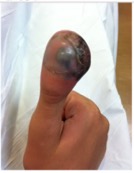Hematology/Oncology
Warm & Blue: A Case of Methemoglobinemia
DOI: https://doi.org/10.21980/J8591MThe patient hadperioral cyanosis, blue coloration around her mouth, but the rest of the skin on her face appeared normal. She also had acrocyanosis to bilateral hands that can be seen in the image. The patient has a tan complexion up to the level of her wrists, but the palms of her hands are pale and cyanotic.
Acute Hemolytic Transfusion Reaction
DOI: https://doi.org/10.21980/J88D2ZBy the end of this simulation session, the learner will be able to: 1) Recognize the clinical signs and symptoms associated with transfusion reactions. 2) Discuss necessary systems-based management of potential transfusion reactions, such as notifying the blood bank and evaluating to see if another patienta accidentally received a wrong unit of blood. 3) Discuss the management of various transfusion reactions. 4) Appropriately disposition the patient to an intensive care unit (ICU) or stepdown unit. 5) Effectively communicate with team members and nursing staff during the resuscitation of a critically ill patient.
Rare Rapidly Growing Thumb Lesion in a 12-Year-Old Male
DOI: https://doi.org/10.21980/J8B92JHistory of present illness: A 12-year-old male presented to the emergency department with right thumb pain and a mass for four months (see images). He denied fevers, chills, change in appetite, or fatigue. He noted that the lesion was growing and “bleeds easily if bumped.” He denied any trauma to the thumb, except “hitting it” months ago while in football
Bedside Echocardiography for Rapid Diagnosis of Malignant Cardiac Tamponade
DOI: https://doi.org/10.21980/J82S38The video shows a subxiphoid view of the heart with evidence of a large pericardial effusion with tamponade – note the anechoic stripe in the pericardial sac (see red arrow). This video demonstrates paradoxical right ventricular collapse during diastole and right atrial collapse during systole which is indicative of tamponade.1,2
Figure 1 is from the same patient and shows sonographic pulsus paradoxus. This is an apical 4 chamber view of the heart with the sampling gate of the pulsed wave doppler placed over the mitral valve. The Vpeak max and Vpeak min are indicated. If there is more than a 25% difference with inspiration between these 2 values, this is highly suggestive of tamponade.1 In this case, there is a 32.4% difference between the Vpeak max 69.55 cm/s and Vpeak min 46.99 cm/s.
Transfusion Related Emergencies
DOI: https://doi.org/10.21980/J86P4VAt the end of this didactic session, the learner will be able to: 1) list the various transfusion reactions and their approximate incidence; 2) understand the pathophysiology behind each transfusion reaction; 3) describe the management for each type of transfusion reaction; and 4) discuss the plan for prevention of future transfusion reactions.
Emergencies in Hemophiliacs
DOI: https://doi.org/10.21980/J8301WBy the end of this session learners will be able to: 1) describe the underlying deficiencies of hemophilia A and B; 2) discuss the complications of hemophilia; 3) formulate an appropriate treatment plan for an acutely bleeding hemophiliac; 4) calculate the appropriate factor dosing for a hemophiliac with acute bleeding.
‹2
Page 2 of 2




